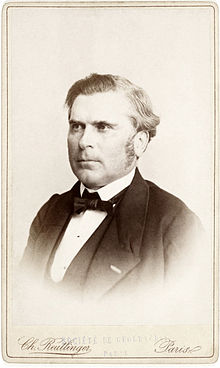Edmond Hébert
Edmond Hébert (born June 12, 1812 in Villefargeau , † April 4, 1890 in Paris ) was a French geologist and paleontologist.
Life
Hébert attended the College de Meaux in Auxerre and from 1833 the École normal supérieure (ENS). In 1836 he became a professor at the grammar school (Lycée) of Meaux , but soon afterwards went back to the École Normale Supérieure to the physical-chemical laboratory as a demonstrator (administrator of the physical-chemical collection) and became Sous-Directeur d'Études there in 1841. Originally he wanted to turn to physics, but a geological excursion to Normandy under Elie de Beaumont made him turn to geology. In 1852 he became Directeur d'Études at the ENS. After he had already acquired a solid reputation in geology, he received his doctorate in paleontology on the fossil mammal Coryphodon in 1857 (Thèse de doctorat) and in the same year became professor of geology at the Sorbonne as the successor to the recently deceased Constant Prévost .
He dealt in particular with the stratigraphy of the Cretaceous and Tertiary periods in France and neighboring countries (such as Great Britain, southern Europe). He first described Gastornis in 1855 .
From 1877 he was a member of the Académie des Sciences and in 1879 he was elected a corresponding member and in 1873 a foreign member of the Bavarian Academy of Sciences . In 1885 he became commander of the Legion of Honor . He was three times President of the Société géologique de France . In 1879 he received the Lyell Medal . In 1878 he was president of the first international geological congress in Paris.
literature
- Hébert, Edmond . In: Encyclopædia Britannica . 11th edition. tape 13 : Harmony - Hurstmonceaux . London 1910, p. 167 (English, full text [ Wikisource ]).
Web links
- Biography. Annales des Sciences Geologiques (French)
Individual evidence
- ↑ Member entry of Edmond Hébert (with picture) at the Bavarian Academy of Sciences , accessed on February 16, 2016.
| personal data | |
|---|---|
| SURNAME | Hébert, Edmond |
| BRIEF DESCRIPTION | French geologist |
| DATE OF BIRTH | June 12, 1812 |
| PLACE OF BIRTH | Villefargeau |
| DATE OF DEATH | April 4, 1890 |
| Place of death | Paris |
